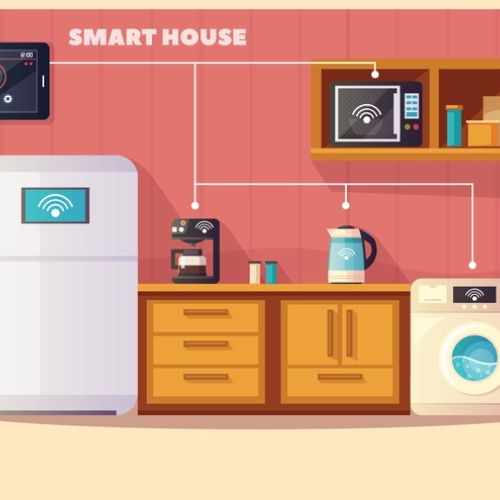Uncategorized
Smart Shopping: Financial Tips for Buying Smart Home Electronics Without Overspending
Smart home devices are transforming our living spaces into more efficient and interconnected environments. Whether it’s smart security cameras, voice-controlled speakers, or automated lighting systems, these advanced technologies make daily tasks more manageable. However, the excitement of creating a fully automated home can sometimes lead to overspending. In this article, we’ll explore how to enjoy the benefits of smart home electronics without straining your finances.
1. Create a Prioritized Smart Home Wishlist
When it comes to smart home devices, the range of options is vast, and it can be overwhelming to choose what to buy first. Before making any purchases, create a prioritized wishlist of the devices you want, starting with the essentials. For instance, you might rank a smart thermostat or security system higher than entertainment devices like a smart speaker.
By focusing on the most important devices first, you can prevent impulsive purchases and make informed decisions based on your actual needs and budget. It also helps to break the upgrades into manageable phases, which will ease financial pressure.
Tip: Evaluate the devices that will provide the most value in terms of convenience and cost savings to prioritize your purchases.
2. Research Features and Avoid Overpaying for Extras
It’s tempting to go for the latest high-end devices with all the bells and whistles, but these features often come at a premium. Many smart home devices have different versions, ranging from basic to advanced models. However, not every additional feature is necessary for your home.
Before making a purchase, research the features of each device and consider if you’ll truly use them. Often, the mid-range model will meet your needs without the extra costs associated with premium versions. Be wary of paying extra for upgrades you don’t need.
Key Takeaway: Focus on the features that will actually benefit you, and avoid overpaying for unnecessary extras.
3. Set a Monthly Spending Limit

For those who want to upgrade their entire home, setting a monthly spending limit can help spread out the cost and prevent financial strain. For instance, allocate a set amount each month for smart home purchases. This disciplined approach ensures that you can gradually build your smart home without draining your savings or falling into debt.
By setting a clear limit, you’ll be able to better manage your overall budget, stay on track with your financial goals, and avoid the temptation to splurge on multiple devices all at once.
Tip: Stick to your monthly spending limit and resist the urge to go over it during big sales or promotions.
4. Look for Bundles and Package Deals
One of the best ways to save on smart home devices is by looking for bundle deals. Many manufacturers and retailers offer packages that include several devices at a discounted price. For example, you might find a deal that includes a smart thermostat, security camera, and smart lock in one package.
Buying in bundles can help you save compared to purchasing each device separately. Additionally, bundled packages often include complementary devices that work well together, making installation and setup easier.
Pro Tip: Check online retailers and home improvement stores for smart home bundles during sales events or when launching new product lines.
5. Track Prices and Wait for Sales

Smart home devices are often subject to seasonal sales, with significant discounts available during events like Black Friday, Cyber Monday, and year-end clearance sales. Instead of purchasing immediately, track the prices of the devices you want over time. Many websites offer price-tracking services or apps that alert you when a product’s price drops.
Waiting for sales can save you a considerable amount of money, especially on high-ticket items. Additionally, retailers often introduce new versions of devices at certain times of the year, leading to discounts on older models that may still meet your needs.
Tip: Sign up for newsletters and price alerts from retailers to stay informed about upcoming sales and promotions.
6. Consider Refurbished or Open-Box Products
Refurbished or open-box products can offer significant savings compared to buying brand-new items. These are devices that have been returned, repaired, or simply opened and tested but still function like new. Most come with warranties and have been inspected to ensure they meet the manufacturer’s quality standards.
Opting for refurbished smart home devices can reduce costs by 10-30%, and in some cases, even more. Many major retailers, including Amazon and Best Buy, offer certified refurbished products with the same functionality as new devices but at a much lower price.
Pro Tip: Always check the warranty and return policy before purchasing refurbished items to ensure you’re protected in case of any issues.
7. Use Smart Devices to Lower Utility Bills
One of the major benefits of investing in smart home electronics is the potential for long-term savings on utility bills. Devices such as smart thermostats, smart plugs, and energy-efficient appliances help reduce energy consumption, leading to lower monthly costs. For example, smart thermostats can automatically adjust the temperature based on your habits, preventing wasteful heating or cooling when you’re not home.
By strategically choosing smart devices that help lower your utility bills, you can recoup the cost of your investment over time. This not only benefits your wallet but also makes your home more environmentally friendly.
Key Takeaway: Choose energy-efficient smart devices that can help reduce your electricity and water bills in the long run.
8. Take Advantage of Financing Options
If you’re eager to upgrade your home but don’t want to spend a large sum upfront, many retailers offer financing options with low or zero interest rates. These plans allow you to spread the cost of your purchases over several months without additional fees.
However, it’s crucial to read the terms carefully before committing to a financing plan. Ensure that you’re aware of the payment schedule, any potential fees, and whether you can comfortably meet the repayment requirements.
Tip: Use financing options only if you’re sure you can make the payments on time and avoid penalties.
9. Avoid Unnecessary Subscription Costs
Many smart home devices come with associated apps or services that require monthly or yearly subscriptions for full functionality. While some subscriptions are necessary for advanced features (such as cloud storage for security cameras), others may offer benefits that you don’t need.
When purchasing a device, check whether it requires a subscription and assess if the cost is justified. If possible, opt for devices that provide the features you need without ongoing subscription fees to avoid adding unnecessary recurring costs to your budget.
Pro Tip: Prioritize devices that offer free or one-time-payment apps over those with expensive subscription models.
Conclusion
Building a smart home can bring convenience, security, and energy efficiency to your life, but it’s important to approach it with a well-thought-out financial plan. By setting a budget, prioritizing essential devices, and being patient for sales or discounts, you can enjoy the benefits of smart home electronics without overspending.
Keep in mind that a gradual approach, combined with wise financial strategies, will help you create a smart home that suits both your lifestyle and your financial goals. In the end, smart shopping ensures you get the most value from your investment while maintaining financial stability.
Learn more: Zgladnews fashion


